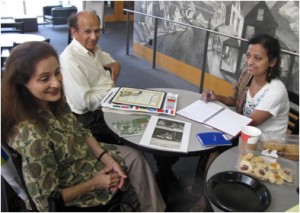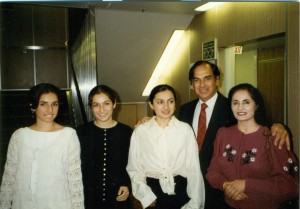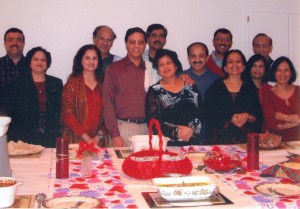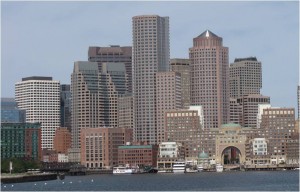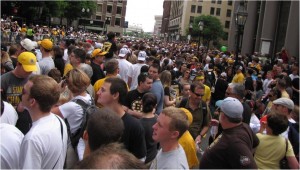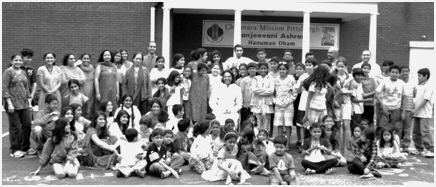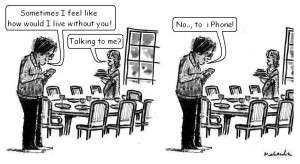Archive for September, 2011
Phipps Conservatory to Unveil Plans for Tropical Forest India in October Gala
Posted by admin in October 2011 on September 29, 2011
Phipps Conservatory and Botanical Gardens is pleased to announce the Wines Under Glass: Passage to India event, to be held on Friday, October 21 at 6:30 PM in the Conservatory. Guests at this special occasion will join Event Co-Chairs Sunil & Nita Wadhwani and Anuj Dhanda & Anne Nemer to revel in the garden as exciting plans are unveiled for next year’s Tropical Forest India exhibit and sustainability stars are chosen for the annual Green Heart of Pittsburgh award. So, mark your calendar.
This event represents the first-ever celebration of the upcoming February 2012 opening of Phipps’ Tropical Forest India, which promises to be the finest exhibit on the flora, cultures and people of India.
Attendees will enjoy superb Indian performers, a bounty of choice Indian delicacies, buzzing friends and entertainers, fine wines, signature cocktails, and tantalizing auction treasures.
The unforgettable evening begins with a VIP Reception at 6:30 pm in the Tropical Forest Conservatory and its Special Events Center, featuring a special selection of food and wine; a 7:30 pm Green Heart Reception follows with a live auction, the Green Heart Awards and more. Tickets are available for purchase now at
http://phipps.conservatory.org/exhibits-and-events/featured-event.aspx?eventid=557 or by contacting Joe Reed by phone at 412-441-4442, ext. 3966. For other questions contact Greg DuFour, Director, Development Campaign at ext. 3701, or by e-mailing to gdufour@phipps.conservatory.org
Phipps was founded in 1893 as the nation’s first teaching conservatory and the largest and finest glasshouse exhibitory of its time. Esteemed today as an eco-champion among North America’s 500 public gardens and arboreta, it is a leading horticultural showcase and educator. For its efforts, Phipps has been the subject of national and international attention:
-
 In September 2009, Phipps had the honor of hosting the G-20 world leaders for their summit’s three opening events;
-
in May 2010, USA Today recognized Phipps as one of America’s top 10 public gardens;
-
in June, PBS stations nationwide aired Growing a Greener World, a program which recognized Phipps as “America’s greenest public garden;†and
-
in November, Phipps Executive Director Richard Piacentini received the prized 2010 U.S. Green Building Council’s Individual Leadership Award, recognizing green building leaders and visionaries, in its first-ever award to an individual in the NGO category.Â
Juginder and Dolly Luthra: Reviving Weirton’s Festival of Nations
Posted by admin in October 2011 on September 29, 2011
Reviving Weirton’s Festival of Nations
By Nandini Mandal      e-mail:  nandini@nandanik.com
Note: Nandini Mandal, the artistic director of Nandanik Dance Academy, recently spoke to Juginder and Dolly Luthra of Weirton, WV, on their participation in reviving Weirton’s Festival of Nations, last held in 1944. She met the Luthras at CMU.
Their story started as a Bollywood-style romance. From the forced migration during India’s painful Partition in 1947, to fifty years later, reviving a defunct Festival of Nations in Weirton, WV, through organizing an Indian Cultural Day there. And their story still continues.
He was born in Multan, in Pakistan now. His family, like other millions, was uprooted during the 1947 Partition and settled down in Panipat, in today’s Haryana, India. Seventh child in the family, he joined the medical school in Amritsar in 1961, obeying his father’s decision.
Three years later, a lovely young lady joined the same medical school in dentistry. Originally from Bombay, she moved to Chandigarh as her father was part of Le Corbusier’s architectural team that built Chandigarh. At the college social, they were part of the play together, with the lovely woman getting the best actress prize. He, Juginder, was in his third year, and she, Dolly, was in her first. And the rest was their destiny together.
Juginder and Dolly were married in 1968, and they moved to the U.K. in 1974 with their first daughter Namita. Juginder Luthra, an ophthalmologist, got his advance diploma in UK. Soon after, their twin baby girls, Rohini and Rashmi, arrived. The Luthras eventually wanted to reach the US shores.
With America still recovering from the Vietnam War, there was a dearth of qualified and experienced doctors in many cities, including Weirton, WV. One of his friends already in Weirton asked him to come to Weirton to practice medicine. In 1975, the Luthras arrived at Weirton with their three daughters.
While Dolly stayed home for eight years to raise their daughters before starting her dentistry practice, Juginder worked as a house physician at the Weirton Medical Center. Weirton was now their home away from home. Juginder recalls, “Our neighbors embraced us, giving us car rides, taught us driving in our very early days as immigrants.â€
To find out how this Punjab da puttar (son of Punjab) became intertwined with the heart and soul of Weirton decades later, we need to understand Weirton’s history built around steel. The economy of Weirton (population 30,000 at its peak) was driven by the steel mill with 13,000 employees at its peak.
In 1909, Ernest T. Weir established a Tin Plate Mill near Holliday’s Cove, a farming village, calling it Weirton, an unincorporated company town. With the expanding mill and an influx of European immigrants, Weirton was incorporated in 1947 by merging several neighboring communities around the mill.
As is the case with all steel towns in the US, Russian, Polish, Greek, Slavic, Italian, Finnish, Hungarian, Welsh, Dutch, Spanish immigrants, and native African-Americans flocked to Weirton in the early 20th century. The interactions among the disparate immigrant groups were not always smooth. A large number of immigrants living in close proximity in a small, isolated town without a strong common American identity was a cause for concern for leaders of the community.
So, in 1934 Weirton’s civic and business leaders conceived a Festival of Nations to foster a sense of fellowship and social and cultural interactions among the ethnic groups. They wanted to showcase the diverse culture in a noncompetitive atmosphere. They succeeded in their mission, and until 1939, the Festival of Nations continued in this spirit with ten nationality groups’ participation in the thousands.
Then World War II started in 1939, ending in 1945. The returning victorious soldiers and the people at large were forged with a common American identity. With this, the rationale for the Festival of Nations too ended, the last one was in 1944.
Good times roared for decades. But with steel’s decline in the 70s, Weirton was devastated like other US towns built around steel. Today Weirton’s population is only 19,000, with only 1000 in steel! Weirton is a now a bedroom community to people working in Robinson Township and the Airport areas.
Flash forward to 2006. The Luthras, now well-established in Weirton, and both ardent art lovers and patrons, decided to showcase India’s dance and musical extravaganza to the people of Weirton. They dipped into the Indian talent in Pittsburgh with artistes trained in India’s rich musical and dance traditions. Sponsored by the Weirton Area Museum and Cultural Center, the Luthras organized the event with Nandanik Dance Academy, Nidrita and Asish Sinha, and Sushanta Banerjee performing in an hour-long program. It was a hit with the audience.
Impressed by the event, Weirton Mayor William Miller, surprised the Luthras by declaring November 18, 2006 “India Heritage Day†in Weirton. The Luthras, now members of the Board of Directors for the Weirton Area Museum and Cultural Center, added a new dimension to Weirton’s cultural landscape.
Then came the Weirton’s centennial in 2009. In a meeting participated by Weirton’s civic and business leaders and community organizers, old-timers wanted to revive the Festival of Nations. Juginder says, “Many of us, including those who have lived here for a long time, had never heard of it before. When they heard about the festival from old-timers, everyone asked me, ‘Why don’t we create something like you did on India?’â€
Weirton’s glorious legacy, now seen through faded photographs and recalled by elders helped in its revival in 2009. The Luthras were active –- for three years, they were the chair and co-chair of the organizing committee — trying to reconnect to Weirton’s past with help from countless citizens of Weirton.
The Festival of Nations was re-started in 2009 with a parade, all singing We are the World at the Municipal Building, with artistes from Weirton and its extended neighborhood including Pittsburgh participating
Every year, attendance improved, starting from mere 400 to over 1600 people this year with twenty-one ethnic groups participating. Indians, Chinese, Koreans, and Japanese are the new entrants. People come back to participate in the parade, buy artifacts from display tables, and taste the featured multiethnic food. The Luthras made sure the gala started with an invocatory piece by Dell Fryer, or Chief White Panther, a Delaware Native American chief.
Now having acquired a building for the museum with a grant of $30,000 from the J.C. Williams foundation, the Luthras and their fellow townsmen are pleased that they were able to revive the Festival of Nations. While recognizing that the festival had seen better days in the past, they hope that it will grow in the years ahead.
Dolly Luthra says, “When my father, a PWD (Public Works Department) engineer, was part of the team that built Chandigarh in India, little did I know that decades later, I will be involved in trying to rebuild another city not physically, but culturally, far away from India. That is very satisfying to me.â€
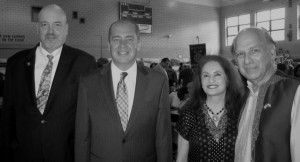
L ro R: Dennis Jones, President, Weirton Area Museum and Cultural Center; Gov. Earl Ray Tomblin of West Virginia; and Dolly and Juginder Luthra.
The Luthras are also path breakers in other ways. They are the founding members of Triveni, a cultural organization with Bangladeshi, Indian, Pakistani members to share the common ethos of the Indian subcontinent. Under the Triveni banner, in 2010 the Luthras were instrumental in showcasing the creativity of visual artists among Indians in the Pittsburgh Metro area under one roof in Monroeville to display their works.
Soft-spoken and warm, the Luthra’s dedication to Weirton that has seen better days is admirable. The Luthras went forward with the limited resources they had.
Along the way, in their efforts to rebuild the Weirton’s glorious legacy, they have befriended a diverse cross section of people in the community. Weiron too, has embraced them even tighter than before.
I need your votes to serve you better.
Posted by admin in October 2011 on September 29, 2011
By D. Raja
Editor’s note: Raja is the Republican candidate in the November election for the Chief Executive for Allegheny county. He faces Rich Fitzgerald, Democrat.
 I am really excited to be running for Allegheny County Executive. As many of you are aware, this is the third highest position in Pennsylvania behind the Governor and Mayor of Philadelphia.
I am really excited to be running for Allegheny County Executive. As many of you are aware, this is the third highest position in Pennsylvania behind the Governor and Mayor of Philadelphia.
Let me provide the “executive summary†version as to why I am running. I came to Pittsburgh about 25 years to go to school and Allegheny County has given me the opportunity to be successful. I don’t see this opportunity being available to our kids and grandkids now. I have the private sector experience as CEO creating jobs and public sector experience as Mt. Lebanon Commissioner addressing budget shortfalls and even cutting taxes. Allegheny County has unbelievable potential; however, we are in a slow decline due to “business as usual†politics. With my private and public sector experience, I know what need to be done to achieve our full potential in Allegheny County and want to bring us back to being a region for opportunity and economic prosperity.
I am including a question that many voters in Allegheny County have along with my response.
Q. Can a guy born in India ever expect to win in Allegheny County?
A. Let me share the response that key democratic elected official’s mother came up with: “If you can trust your life to an Indian Doctor, you most certainly can trust Allegheny County to an Indian CEO.â€
Like many of the readers, I came to Pittsburgh twenty-five years ago to complete my education and for my chance at the American dream. I got my Masters in Computer Science from Pitt and an MBA from Carnegie Mellon University. Shortly after I came to Pittsburgh, I joined Lockeed and spent about six years with this company. Lockheed moved its top management from Pittsburgh to the Silicon Valley. I went to the Silicon Valley and after spending time there realized that Allegheny County was home for me.
Let me share some of the opportunities that Allegheny County has provided to me. I co-founded a business in the spare bedroom of my South Hills apartment about 18 years ago. Today, I am proud to say that we are still headquartered in western Pennsylvania and employ hundreds of men and women designing and building software for businesses all around the country. In 2007, I ran a heavily contested race for Commissioner in
Mt. Lebanon. I ran with a simple approach of a vision for Mt. Lebanon with specific actions to meet the vision and I won by a large margin. Mt. Lebanon has faced severe shortfalls each year since I have been on the Commission. I not only found ways address the shortfalls but also pass along two tax cuts during the past three years.
I met my wife, Neeta, an internist, in Pittsburgh and we live in Mt. Lebanon with our two daughters Isana (9) and Omisa (7).
As the numbers of Indians in the greater Pittsburgh area have grown, we have become an essential part of the community, contributing in many areas such as medicine, engineering, and business. We, as Indians, have a long tradition of not being afraid of challenges and adversity; this has helped us to succeed in any area we choose to enter.
Now we have an opportunity to also make an impact in another arena in our region now : politics. We, as a people also have a generosity of spirit, and in helping others in any way we can. This is another way in which we can make a difference and contribute back to the community that provided us the opportunity to be successful. I am doing my best to bring as much positive exposure to the Indian American community in my campaign. Our community should look forward to an Indian American being able to achieve the Presidency of this great nation sometime soon.
I am committed to winning this race and have been working very hard on the campaign since winning the primary. Given the voter registration disadvantage, I need your help to win. Please join my team and help get the vote out, arrange fundraising events, get your friends/colleagues to attend the townhalls, put up our 4×8 signs or participate in any other way. Details the townhalls etc are available at www.joinraja.com.
I welcome your feedback. Please do not hesitate to contact me at 412-567-8448 or raja@joinraja.com. Thanks.
Celebrating India, Now a Pittsburgh Tradition
Posted by admin in October 2011 on September 29, 2011
By Shobhitha Ravi   e-mail: shobhitha.ravi@verizon.net
Editor: Shobhitha, raised in the Pittsburgh area, is pursuing her master’s degree in teaching at Pitt. She is passionate about India’s classical and folk dances and now teaches classical dance in the Pittsburgh. Shobitha’s I-Day pictures are used in this story.
Celebrating India’s Independence has become an annual event here in Pittsburgh. This gala – we can also call it a mela — always takes place on the Sunday nearest to August 15th, the official India Independence Day, at Pitt’s Cathedral of Learning in Oakland. In recent years, weather permitting, the program starts with a parade around the Cathedral with singers and dancers scattered throughout the parade.Â
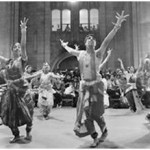 The possibility of rain this year did not prevent the parade from taking place. It was kept indoor and rerouted from the Cathedral Commons up to the Indian Nationality room with people waving hand-held Indian flags with pride.Â
The possibility of rain this year did not prevent the parade from taking place. It was kept indoor and rerouted from the Cathedral Commons up to the Indian Nationality room with people waving hand-held Indian flags with pride.Â
This event drew in, as it always does, a wide cross section of people of Indian origin with young children, high-school and college students, parents, and grandparents illing the room. Several people from the American mainstream too were there in the gala.Â
The program opened with the singing of both the US and Indian national anthems followed by public speeches, flag hoisting, and dance and musical items. A wide range of performances were staged from classical dances to Bollywood items to the energetic Bhangra, and popular and India-themed songs; and the crowd appreciated each one.Â
The attendees took turns crowding around the stage to get a glimpse of each program allowing for an engaging and dynamic environment.Â
The organizers have finally succeeded in developing a format that emphasizes India’s rich and classical folk tradition keeping the Bollywood items to a few numbers.
With the several performances and speeches, this event has become one that all Indians truly look forward to every year as a time to come together and celebrate.Â
In addition to the programs, people come to enjoy the food and other activities offered as well. The lobby was lined with food stalls and tables for charity organizations, mehndi artists, ready-made garments, and saris, which together made the cultural ambience of the Independence Day celebration.Â
The Cathedral became a lively mini-India. For many, it is a time to reunite with familiar faces and for those new, it is a time to meet future friends. It is a tradition that will continue in Pittsburgh for many, many years to come.
This year, Anju Chopra and Sumedha Nagpal emceed the program, and Dean Ramayya Krishnan from CMU was the keynote speaker. The Indian Nationality Room Committee — Saroj Bahl, Rashmi Ravindra, Ranjani Shankar, G.G. Hegde, Shernaz Cama, Nita Wadhwani and S. Ramgopal – is at the forefront of this annual event.
Ayurveda — The Science of Life
Posted by admin in October 2011 on September 29, 2011
By Daniel Casciato
Western PA Hospital News & Pittsburgh Better Times
Phone: 412.607.9808Â Â Â Â e-mail: writer@danielcasciato.com
Ayurveda is one of the fastest growing complimentary healing systems in the United States and offers a unique preventive approach for restoration of health.
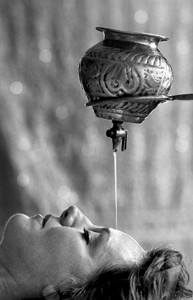 This 5,000-year-old natural healing science is experiencing a major resurgence not only in its native land of India, but throughout the world. Thanks to Dr. Lina Thakar, an Ayurvedic physician from India with over 15 years of experience, Ayurveda has now come to Western Pennsylvania. Ayurveda Wellness Center & Holistic Spa is the first and only authentic Ayurveda center in Pittsburgh and the Tri-state area offering traditional Ayurvedic treatments.
This 5,000-year-old natural healing science is experiencing a major resurgence not only in its native land of India, but throughout the world. Thanks to Dr. Lina Thakar, an Ayurvedic physician from India with over 15 years of experience, Ayurveda has now come to Western Pennsylvania. Ayurveda Wellness Center & Holistic Spa is the first and only authentic Ayurveda center in Pittsburgh and the Tri-state area offering traditional Ayurvedic treatments.
Ayurveda applies various natural methods to complement the treatment of specific illnesses so that the recovery is fast and prevents recurrence. Through Ayurveda, Dr. Lina says, you can reconnect and uncover genuine wellness and ultimate rejuvenation.
“We know that health is not a transitory feel good that takes place on an occasional spa visit. It is about feeling right and looking good, always,†says Dr. Lina, who is also affiliated with Allegheny General Hospital’s Integrated Medicine Program that offers an integrated approach to conventional and natural healing practices.
Since managing stress is a lifelong process, their spa services are aimed at longer lasting benefits. Dr. Lina and her staff try to remove the root causes of stress and not just the symptoms.
“We’ll give you the power and the tools to feel right, light, and beautiful inside,†she adds. “Whether you’re seeking a wellness consultation, spa therapy, nutrition and cooking session, natural beauty treatment, or a detoxification program, we’ll help you restore balance and reawaken your body’s natural healing mechanisms.â€
To support your Ayurvedic lifestyle, Ayurveda Wellness Center & Holistic Spa also features a retail shop which carries an array of Ayurvedic herbal oils, dietary supplements, natural beauty and skin care products, as well as Dr. Lina’s own product line.
To learn more, visit www.ayupgh.com or like them on Facebook at www.facebook.com/AyurvedainPittsburgh.
Ayurveda Wellness Center & Holistic Spa 5168 Campbells Run Rd., Suite 204. Pittsburgh, PA 15205 Hours: Mon to Sun, 9am-5pm. Evening hours by appointment. Phone: 412.809.0999 Email: info@ayupgh.com Â
Obituary: Dr. K.N. Rao, July 1937 – July 2011, Toxicologist
Posted by admin in October 2011 on September 29, 2011
 By Nagasankar Rao Dittakavi, MacDonald, PA
 Editor’s Note: Naga Sankar Rao Dittakavi, a long-time resident in the area, is an Associate Director of the Center for Legal Information at Duquesne University, Pittsburgh.
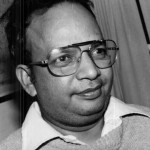 Dr. Kalipatnapu Narasimha Rao, simply known as Dr. K.N.Rao to his friends and colleagues, died on Monday, July 4, 2011 after a prolonged illness. Born in 1937 in Andhra Pradesh, India, K.N.Rao earned his bachelor’s degree in chemistry from Bombay University, and master’s in organic chemistry from Nagpur University. He completed his PhD in biochemistry at the prestigious Indian Agricultural Research Institute, New Delhi.
Dr. Kalipatnapu Narasimha Rao, simply known as Dr. K.N.Rao to his friends and colleagues, died on Monday, July 4, 2011 after a prolonged illness. Born in 1937 in Andhra Pradesh, India, K.N.Rao earned his bachelor’s degree in chemistry from Bombay University, and master’s in organic chemistry from Nagpur University. He completed his PhD in biochemistry at the prestigious Indian Agricultural Research Institute, New Delhi.
 Dr. Rao joined the University of Pittsburgh Medical Center in 1971 as a research associate in the department of pathology, where he later became a professor. He was with UPMC for thirty-four years.
 With his expertise in toxicology, he was the expert witness in several medicolegal cases. Even towards the very end of his life, he was academically active, completing a textbook entitled, “Forensic Toxicology: Medico-legal Case Studies,” published by CRC Press.
 Keen to help India, Rao was involved in founding a research program in late 90’s at the Nizam’s Institute of Medical Sciences in Hyderabad. In the year 2001 he helped in establishing a clinical toxicology laboratory at the Hinduja National Hospital and Medical Research Center in Mumbai, India.
 Rao enjoyed listening to Indian classical music and film songs. He was a fan of the actress-singer-director P R Bhanumathi. He loved to play tennis with his children and friends. Rao was a man of deep faith, attending many functions at the S.V.Temple, where he and his wife Rama volunteered for many years.
 In the early days of Indian immigrants’ life in this region, he hosted many newcomers in his house, helping them to get acquainted with the local culture and food habits. I was one among them.
 He married Rama in 1965, who fondly recalls that Rao encouraged her to obtain a master’s degree in Library and Information Science at the University of Pittsburgh.
K. N. Rao’s end came at the Vassar Brother Hospital, Poughkeepsie, NY, where he was visiting his daughter on June 20th 2011. His son Babu perfomed the Hindu cremation rites at the Poughkeepsie Rural Cemetery. Dr. Rao leaves behind his wife Rama; daughters Dr. Padma Garvey, Dr. Uma Purighalla; son Babu; and three grandchildren Joe Joe, Sandhya and Radha. And a large circle of friends and relatives.
A memorial service for K. N. Rao was held on August 20th at the University Holiday Inn, Oakland, where the Rao Family requested that donations be made to the American Diabetes Association, P.O. Box 11454, Alexandria, VA 22313. Readers too can send their contributions directly to the American Diabetes Association.
Â
Unexpected Boston Encounters
Posted by admin in October 2011 on September 29, 2011
By Premlata Venkataraman
email: thepatrika@aol.com
Travelling in commuter trains is natural to me. I spent my teenage years in Bombay daily commuting on suburban trains from the suburbs to Churchgate on the “7:12 superfast.” I’m sure you’ve heard of the notorious Bombay train — overcrowded, with commuters literally hanging by their fingertips. Enough said. I am comfortable in crowded trains.
 Well, this premise was severely tested recently on a trip to Boston in June. On an impulsive mini-vacation, we found ourselves in a hotel not near the Boston harbor area, the tourist attractions in the city. It was at the end of a short ride on the T, Boston’s commuter train network.
 Public transportation lets you get to know the city intimately by observing everyday folks go about their work, and this has always appealed to me. So familiarizing myself with a handy map, I jauntily stepped in and out for rides several times during our weekend stay.
 Top on my agenda was walking the Freedom Trail and soaking in all the history of the American Revolution, which originated in Boston. Imagine my surprise on getting to the station on the Saturday morning to a feeling that I had been transported in a wicked travel machine to Mumbai’s Victoria Terminus during rush hour. Except, none of the milling crowds around me was brown!
 The line to buy metro cards snaked out into the streets. Not an ice hockey fan, I had paid little attention that the Bruins, Boston’s hockey team, had won the Stanley Cup. And now, all of Boston was decked in their finest Black-and-Gold (the teams colors), ready to party big time with its new champions! Maybe, it was the familiar Black-and-Gold that lulled my fears. Undaunted we made a spot decision to go ahead with our plans.
 The train arrived. Seeing the trainful of Bruins fans packed like sardines in a tin and pumped up on celebratory fervor, all my decades-past Bombay spirit drained out of me. I balked at walking into the crowd to the doors of the train, in spite of commuters beckoning me inside.
 After a couple of trains had thus gone by, I brought forth all my long-forgotten fortitude and just stepped into a coach full of people, trying to shrink myself into the smallest frame possible. Miraculously I squeezed into a tiny pocket and made eye contact with the Vietnamese women trying to hang on to seat back – unable to reach the handles overhead.
 Finally, we arrived at the Downtown Crossing station and got off the train into the milling crowds. Once we reached the streets, we came to know that we missed the Freedom Trail walk by a few minutes. (Later in the afternoon, when we joined the afternoon Freedom Trail walk, all of us got soaked, not in the history of the American Freedom struggle, but in the plain old-fashioned thunderstorm rains.)
 The crowds, the noise and enthusiasm of the Bruins fans apexed. Having never experienced a Steeler parade after six wins and three Penguin wins in my twenty-five years in the Burgh, I experienced my first sports victory parade in Boston. “Watch out for rowdy drunk Bruins fans,” my daughters cautioned. They worried about their clueless mother doing the kind of risky stuff they had been cautioned against all their lives.
 But the crowds were, for the most part, well behaved though drunk not only on the Bruins victory, but also on the early morning imbibing of Sam Adams. It was fun seeing all the kids, young adults, and oldies too decked out in their best Bruins merchandizing. The noise was deafening as the motorcade rolled down to a burst of drums, vuvuzelas and cheering.
 That evening at the Boston Harbor we did encounter the alcohol-fueled revelers once again. Sitting on a ledge overlooking the harbor contemplating the history lesson and the magnificent Boston skyline on a comfortable sunny day, I was startled as a young man ran past me and jumped nearly twenty feet below into water. Six others soon joined him.
 Later in the evening, after dinner at the Strega’s which had photographs of every Italian star on its walls and several TV screens streaming every Italiano Mob movie ever made, we enjoyed a delectable the Italian dinner.
 So my short visit of Boston blended elements of the familiar (Freedom Trail), the delectable (Italian food), and the unexpected (The Bruins Parade). Boston put on quite a show for me.
Why Balavihar?
Posted by admin in October 2011 on September 29, 2011
 Suresh R. Mulukutla
e-mail: mulukutlasr@upmc.edu
“Children are not vessels to be filled, but lamps to be lit.”–- Swami Chinmayananda
 “Who am I?” “Where did I come from?” “What comes after this?”
 The answers to these questions mature as we cultivate our spiritual core. Children in the US find it challenging to answer the fundamental question “What makes me a Hindu?” My parents took me to India and to temples, and I read the Amar Chitra Katha books. But, is that enough?
 Aside from being born into a Hindu family, understanding the philosophical basis of what makes me unique as a Hindu proved to be an elusive goal. There was something lacking –- the guidance of a guru, and the ability to put my experiences in proper perspective. Many of us know more about other religions than we know about Sanaatan Dharma, (Eternal Order) That is not to say that we shouldn’t learn about other belief systems; they, too, offer valuable lessons. However, the breadth and wealth of Sanaatan Dharma can offer important perspectives upon our lives and aspirations.
 Balavihar’s goal is to impart the Vedantic values of Sanaatan Dharma to our children. We are blessed to have many spiritual/religious organizations nearby – the Chinmaya Mission, Sri Venkateswara Temple, the Hindu Jain Temple, Sri Sai Baba Temple, among others. These organizations and still more dedicated community individuals conduct Balavihar programs. These organizations complement each other, and there is much to be gained by experiencing the best of each of them. The Balavihar that I know best is the Chinmaya Balavihar.
 Why Balavihar?
Sanaatan Dharma is unique in its unequivocal approach to Truth. Through Chinmaya Balavihar, children appreciate Sanaatan Dharma’s core concepts – (1) Truth is one; (2) there are many paths to Truth; and (3) the primary goal is to see the divinity within us. As parents, we give our children material gifts, but is there any greater gift than empowering them about their own unlimited potential?
Why Balavihar?
Our choices have consequences. Balavihar provides the value-based education for children to make the right choices as they grow into responsible individuals who support the community.
Why Balavihar?
With the ancient Gurukula system having faded, a structured Balavihar program is critical. Chinmaya Balavihar is a carefully constructed curriculum from Pre-K to high school covering an incredible breadth of knowledge.
Realizing that studying Vedanta is difficult but teaching it is even more so, the formal teacher training for Chinmaya teachers has been invaluable to allow us to get the right message to children.
 Why Balavihar?
Adults can also grow spiritually and have meaningful discussions with their children about their spirituality by attending Satsangs and Jnana Yagnas.
 Why Balavihar?
“It takes a village to raise a child…” Because of our ethnic differences, many children may develop an “identity crisis.” Balavihar boosts the confidence of our children to feel completely comfortable with their heritage, and recognize that out of diversity comes unity and strength.
Why Balavihar?
Imagine… Your mind is at rest… You are always happy… Everything is perfect. Balavihar gives you the means by which your imagination can become reality.
Through Balavihar, our children realize that when we have “victories,” we can teach others who we are; but when we have “failures,” we can teach ourselves who we are.
 So, the real question to ask ourselves is not “Why Balavihar?” but “Why Not?”
Â
Ha, Ha, Ha!!!
Posted by admin in October 2011 on September 29, 2011
 Natural Born:
They were discussing the qualifications to be President of the United States. It was pretty simple. The candidate must be a natural born citizen of at least 35 years of age. One girl in the class started on how unfair was the requirement to be a natural born citizen. Her opinion was that this requirement prevented many capable individuals from becoming president. She wrapped up her argument thus:
“What makes a natural born citizen any more qualified to lead this country than one born by C-section?”
Legally correct:
A wife asks her husband, “Could you please go to the grocers and buy one carton of milk, and if they have eggs, get six.”
The husband goes and returns with six cartons of milk.
“Why did you buy six cartons of milk?”
“They had eggs.”
Did you read it twice (or more times) to get the joke?
Complete and Finished:
People say there is no difference between “complete” and “finished” in the English language. But there is big difference between the two.
For example, when you marry the right woman, you are COMPLETE.And when you marry the wrong one, you are FINISHED!
And when the right one catches you with the wrong one, you are… … … COMPLETELY FINISHED!!
 Mahendra’s Musings:
 An old Sanskrti verse on the Indian Medica System:


